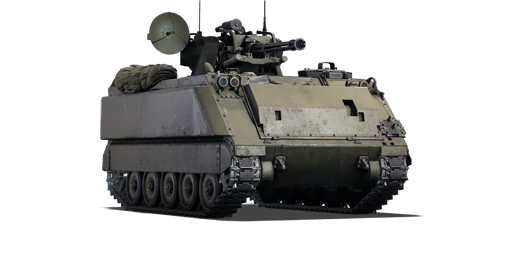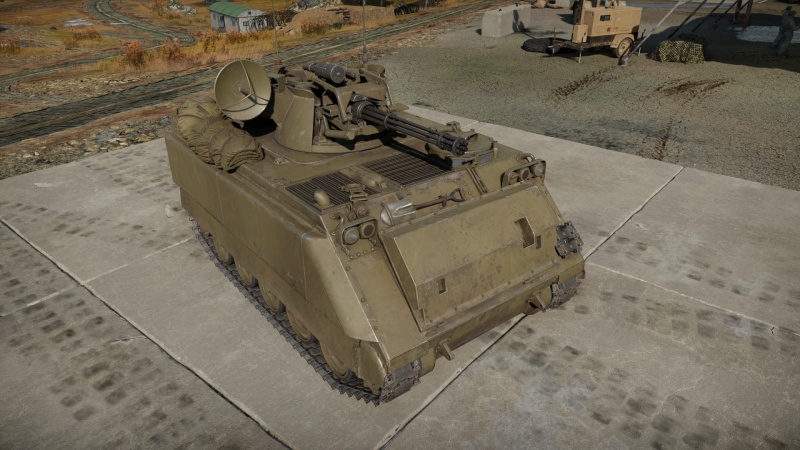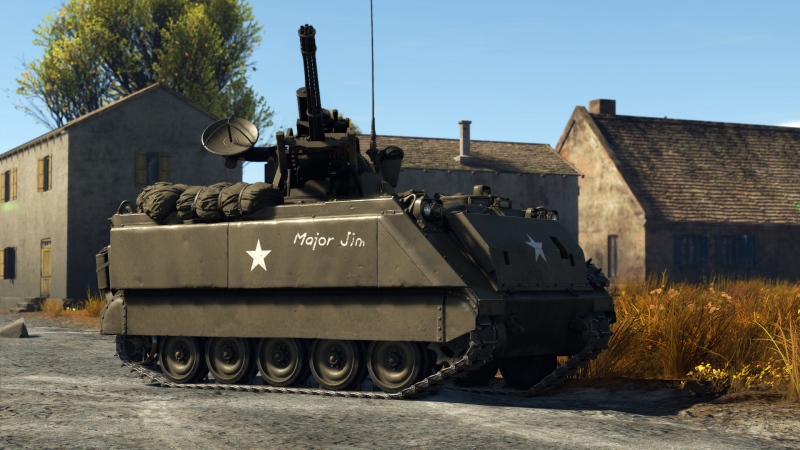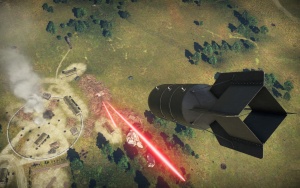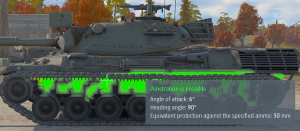Difference between revisions of "M163"
m (Added the name and a short description) |
(→Description) |
||
| (4 intermediate revisions by 2 users not shown) | |||
| Line 11: | Line 11: | ||
== Description == | == Description == | ||
<!-- ''In the description, the first part should be about the history of the creation and combat usage of the vehicle, as well as its key features. In the second part, tell the reader about the ground vehicle in the game. Insert a screenshot of the vehicle, so that if the novice player does not remember the vehicle by name, he will immediately understand what kind of vehicle the article is talking about.'' --> | <!-- ''In the description, the first part should be about the history of the creation and combat usage of the vehicle, as well as its key features. In the second part, tell the reader about the ground vehicle in the game. Insert a screenshot of the vehicle, so that if the novice player does not remember the vehicle by name, he will immediately understand what kind of vehicle the article is talking about.'' --> | ||
| − | + | The US short-range air defence in the early stages of the Vietnam War consisted of the [[M42|M42 Dusters]], however the fast-paced nature of fighter jets meant that the low rate of fire the 40 mm Bofors provided was no longer sufficient. To improve on this, the 20 mm Vulcan cannon used on American jets was utilized as the basis of a new short-range air defence gun, modified into the M168 gun. Installed onto the common M113 chassis with a tracking radar, the design became known as the M163 Vulcan Air Defense System (VADS). The M163 remained in use with the US military until replaced with systems that utilized the [[FIM-92 Stinger]] like the Avenger. | |
| − | Introduced in [[Update 1.63 "Desert Hunters"]], the '''{{Specs|name}}''' provides the necessary short-range air defense capability for the US tech tree. While not as capable nor able to reach out the distance like the larger systems like [[Gepard]], [[Chieftain Marksman]] or [[ZSU-23-4]], the M163 does | + | Introduced in [[Update 1.63 "Desert Hunters"]], the '''{{Specs|name}}''' provides the necessary short-range air defense capability for the US tech tree. While not as capable nor able to reach out the distance like the larger systems like [[Gepard]], [[Chieftain Marksman]], or [[ZSU-23-4]], the M163 does benefit from a very high rate of fire Vulcan armament. Due to the limitations, M163 players may find themselves driving rather close to the front-lines to provide the protection to allies and hit approaching aircraft, so extra care must be taken to not go so far in that an enemy tank will spot the M163. However, when the M163 sends out its tracer load of 20 mm towards the target, it can prove an intimidating sight to the enemies. |
== General info == | == General info == | ||
| Line 98: | Line 98: | ||
{{main|AN/VPS-2}} | {{main|AN/VPS-2}} | ||
The M163 is equipped with an [[AN/VPS-2]] tracking radar, with no search radar. The radar is fitted to the side of the turret. | The M163 is equipped with an [[AN/VPS-2]] tracking radar, with no search radar. The radar is fitted to the side of the turret. | ||
| − | {{Notice|In order to lock on you must be looking through your sight, position the crosshair over a target (within 7 km) and press the lock on key. The target must be within a 2° cone from the centre of the crosshair.}} | + | {{Notice|In order to lock on you must be looking through your sight, position the crosshair over a target (within 7 km) and press the lock on key. The target must be within a 2° cone from the centre of the crosshair. Hold the key until a tracker shows on the plane. When it is in range, a circle will show where to aim for an increased chance of shooting down a plane.}} |
{| class="wikitable" style="text-align:center" | {| class="wikitable" style="text-align:center" | ||
Latest revision as of 17:06, 5 July 2024
| This page is about the American SPAA M163. For other versions, see M113 (Family). |
Contents
Description
The US short-range air defence in the early stages of the Vietnam War consisted of the M42 Dusters, however the fast-paced nature of fighter jets meant that the low rate of fire the 40 mm Bofors provided was no longer sufficient. To improve on this, the 20 mm Vulcan cannon used on American jets was utilized as the basis of a new short-range air defence gun, modified into the M168 gun. Installed onto the common M113 chassis with a tracking radar, the design became known as the M163 Vulcan Air Defense System (VADS). The M163 remained in use with the US military until replaced with systems that utilized the FIM-92 Stinger like the Avenger.
Introduced in Update 1.63 "Desert Hunters", the Gun, Air Defence Artillery, Self-Propelled: 20-mm, M163 provides the necessary short-range air defense capability for the US tech tree. While not as capable nor able to reach out the distance like the larger systems like Gepard, Chieftain Marksman, or ZSU-23-4, the M163 does benefit from a very high rate of fire Vulcan armament. Due to the limitations, M163 players may find themselves driving rather close to the front-lines to provide the protection to allies and hit approaching aircraft, so extra care must be taken to not go so far in that an enemy tank will spot the M163. However, when the M163 sends out its tracer load of 20 mm towards the target, it can prove an intimidating sight to the enemies.
General info
Survivability and armour
Armour is not on the operator's side in the M163, as it is thin enough to be destroyed by 12.7 mm machine guns from the sides and rear, and any cannon-sized armament from the front. The turret is partially open, leaving the crew vulnerable to enemy light arms fire. If attacked, the best bet for taking a hit and surviving is to point the engine towards the enemy and hope it absorbs the shot.
Armour type:
- Aluminum alloy 5083 (hull)
- Structural steel (front and rear fenders)
- Rubber-fabric screens (fenders/sideskirts)
| Armour | Front (Slope angle) | Sides | Rear | Roof |
|---|---|---|---|---|
| Hull | 38+6 mm (45°) Upper Glacis 38 mm (26°) Lower Glacis 29 mm (45°) Engine Maintenance Hatch |
44+6 mm Top 32 mm Bottom |
38 mm | 38 mm |
| Turret | 17 mm Turret Front 150 mm Gun Mantlet |
17 mm | 17 mm |
Note:
- The additional armour does not fully cover the plate it is mounted onto.
Mobility
| Game Mode | Max Speed (km/h) | Weight (tons) | Engine power (horsepower) | Power-to-weight ratio (hp/ton) | |||
|---|---|---|---|---|---|---|---|
| Forward | Reverse | Stock | Upgraded | Stock | Upgraded | ||
| Arcade | 70 | 17 | 11.2 | 301 | 404 | 26.88 | 36.07 |
| Realistic | 65 | 15 | 188 | 212 | 16.79 | 18.93 | |
Modifications and economy
Armaments
Main armament
The M163 is equipped with a 20 mm M168 VADS, or Vulcan air defence system. The M168 is a variant of the M61 cannon, which can be found in-game on vehicles such as the Japanese T-2, and the American F-4C Phantom II. Used initially during the Vietnam war, the M168 was a 20 mm air-cooled rotary cannon attached to a small turret on the M163. Dangerous to anything in the sky, it will lock on and rip through anything in its path.
| 20 mm M168 | Turret rotation speed (°/s) | Reloading rate (seconds) | ||||||||||||
|---|---|---|---|---|---|---|---|---|---|---|---|---|---|---|
| Mode | Capacity (Belt) | Fire rate | Vertical | Horizontal | Stabilizer | Stock | Upgraded | Full | Expert | Aced | Stock | Full | Expert | Aced |
| Arcade | 2,200 (1,100) | 3,000 | -5°/+80° | ±180° | N/A | 66.05 | 91.41 | 111.00 | 122.80 | 130.59 | 26.00 | 23.00 | 21.20 | 20.00 |
| Realistic | 44.63 | 52.50 | 63.75 | 70.50 | 75.00 | |||||||||
Ammunition
- Default: AP-I · HEI-T · API-T
- HEI: HEI-T · HEF-I · API-T · HEF-I
- AP-I: AP-I · API-T · HEF-I · API-T
| Penetration statistics | |||||||
|---|---|---|---|---|---|---|---|
| Ammunition | Penetration @ 0° Angle of Attack (mm) | ||||||
| 10 m | 100 m | 500 m | 1,000 m | 1,500 m | 2,000 m | ||
| AP-I | 40 | 36 | 22 | 12 | 6 | 3 | |
| API-T | 40 | 36 | 22 | 12 | 6 | 3 | |
| HEF-I | 5 | 5 | 3 | 2 | 2 | 2 | |
| HEI-T | 5 | 5 | 3 | 2 | 2 | 2 | |
| Shell details | ||||||||||||
|---|---|---|---|---|---|---|---|---|---|---|---|---|
| Ammunition | Velocity (m/s) |
Projectile mass (kg) |
Fuse delay (m) |
Fuse sensitivity (mm) |
Explosive mass (TNT equivalent) (g) |
Ricochet | ||||||
| 0% | 50% | 100% | ||||||||||
| AP-I | 1,030 | 0.1 | - | - | - | 47° | 56° | 65° | ||||
| API-T | 1,030 | 0.1 | - | - | - | 47° | 60° | 65° | ||||
| HEF-I | 1,030 | 0.1 | 0.1 | 0.1 | 17.12 | - | - | - | ||||
| HEI-T | 1,030 | 0.1 | 0.1 | 0.1 | 12 | 79° | 80° | 81° | ||||
Ammo racks
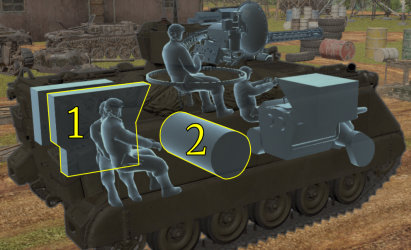
| Full ammo |
1st rack empty |
2nd rack empty |
Visual discrepancy |
|---|---|---|---|
| 2 belts | 1 (+1) | 0 (+2) | No |
Radars
The M163 is equipped with an AN/VPS-2 tracking radar, with no search radar. The radar is fitted to the side of the turret.
| In order to lock on you must be looking through your sight, position the crosshair over a target (within 7 km) and press the lock on key. The target must be within a 2° cone from the centre of the crosshair. Hold the key until a tracker shows on the plane. When it is in range, a circle will show where to aim for an increased chance of shooting down a plane. |
| AN/VPS-2 - Tracking Radar | ||||
|---|---|---|---|---|
| Maximum Tracking Range |
Minimum Tracking Range |
Azimuth Tracking Angle |
Elevation Tracking Angle |
Minimum target speed |
| 7,000 m | 100 m | 360° | -20°/+85° (lock between -20°/+20°) |
15 m/s (54 km/h) |
Usage in battles
The M163 is a support vehicle through and through. Boasting an immense fire rate of 3000 rounds per minute from its M168 Vulcan cannon, the M163 is best used as a point-defense SPAA and a tag team support vehicle, able to quickly destroy the barrels and tracks of any vehicle it can cleanly get shots at without retaliation. Against air targets it is even better due to the introduction of the first tracking radar in the US tech tree with the AN/VPS-2. However, the lack of a search radar may make it more difficult to identify threats to you and your team before they have already attacked.
The high rate of fire also allows the M163 a sort of CIWS (Close-In Weapon System) type of role, as it can easily spray in the direction of an incoming bomb, thus destroying it and saving nearby allies. This is especially easy against the infamous FAB-5000 bomb from the Soviet Pe-8, as the bomb is large and easy to track.
Air engagements.
When facing enemy aircraft, the M163 is amazing at destroying any plane it can effectively get a lock onto with its tracking radar. The radar and fire rate of the vehicle makes it able to fire a hail of bullets at any aircraft or helicopter accurately, usually destroying them in just a quick short burst. The M163 does have a smaller profile than normal tanks, allowing it to stay hidden from the sky much better than more conventional tanks. However, the distinct sound, muzzle flash, and flood of tracers into the sky of the Vulcan cannon will immediately reveal your location and cause any planes and nearby tanks to prioritize the M163 over other targets. Because of this, it is important to only shoot upon enemy aircraft and reveal your presence once they are at a reasonable distance. A good tip is to wait until your tracking radar reads at least 1.5 km or 1 km of distance when shooting aircraft to ensure a kill before they can react and use evasive manoeuvres. Once spotted by multiple air targets, the M163 can have grim times eliminating all threatening aircraft due to its lengthy 23-second reload and paper-thin armour. It is a good idea to make sure you are firing the Vulcan cannon in bursts as tempting as it may be to use it without any break between volleys.
Every plane can easily cut through your armour with their machine guns and cannons before you can react, compounded without the search radar and planes can attack you from unexpected angles to ensure you are not able to retaliate. The M163 is also considered an open top tank; because of this and your lack of armour, bombs and missiles are easily able to destroy you, even after having already destroyed the plane, leading to a lot of engagements ending with both you and your attacker being killed by one another.
At this BR, you will encounter a new threat in helicopters. These vehicles prove to be another hurdle for the M163 to endure and struggle with. Most helicopters have guided missiles that can be launched from outside your effective range and destroy you before you can close the distance or sometimes even spot them. Because of this, you will only be able to destroy these choppers if they come within your effective range. The best tactic against these types of helicopters is to put solid cover between you and the helicopter and focus on other key targets that you can confront, as well as calling out to your friendly aircraft the helicopters' location so you can manoeuvre more effectively once it is destroyed. Some helicopters this tier though do not have any guided missiles, such as the American AH-1G, Japanese UH-1B, Italian AB 205 A-1, and Israeli Tzefa A. These helicopters instead have rocket pods that result in them needing to be much closer to the battlefield to use them effectively. If any of these are actively engaging with your team, you can effortlessly destroy them with your extreme fire rate before they are able to pose a threat.
Tank engagements and ground support.
The 20 mm M168 cannon has 40 mm of penetration, which allows it to destroy only the lightest of armour on the battlefield for its battle rating. Many of these targets are light tanks or SPAA vehicles. Some examples of these common threats you will encounter include the German Marder 1A3 and Raketenautomat, the BMP-1 series, and the ZSU-57-2. The Vulcan cannon has no issues in being able to destroy these targets. When it comes to fighting medium tanks, most will not sustain any damage to the crew and ammo inside by your gun. Because of this, it is better to instead incapacitate and cripple them for your team than waste ammunition trying to mortally wound them. There are a few exceptions though that are important to remember as you alone can dispatch and destroy some of the more lightly armoured medium tanks. These include the German Leopard 1, British Vickers Mk.1 and Vickers Mk.3, Italian OF-40, French AMX-30 (1972), and Swedish Strv 103A. The side armour under the tracks have around 30 mm of thickness which is weak enough for your 20 mm cannon to penetrate, so you are more than capable of destroying these vehicles after disabling them or ambushing them.
The M163 has little to no armour for its battle rating, as everything can easily destroy you before you can do any meaningful damage in a head-to-head fight. This is most apparent when encountering USSR tanks as all of their conventional tanks have a top mounted 12.7 mm DShK machine gun that is easily capable of taking you out alone. The extra front plate on the front of the M163 may catch a few rounds from these machine guns as some angles, but this is hardly reliable in making yourself immune from them.
One tactic you can use to remarkable success is to pair up or follow a Breakthrough tank. These include common tanks you will see such as the Conqueror, M103, and IS-6. As a support vehicle, the M163 is perfect for protecting these common bombing targets from enemy jets and helicopters. When paired with these tanks, the M163 should play more reserve, letting them peek corners and exposing their more reliable and heavy armour to the enemy before engaging yourself. Once they have bounced or absorbed a shot, the M163 can peek at the enemy and disable any exposed barrels and tracks for your teammate while they reload. This is useful for these breakthrough tanks too, due to most having up to 20 seconds of reload before they are able to fire another round, much longer if they also lose their loader to the attacker. When performing this tag team tactic, it is imperative to know your enemy. Autoloading tanks can quickly reload and dispatch you once you reveal yourself to them before you are able to safely disable them. Stronger machine guns such as 12.7 mm M2HB and DShK can also quickly and easily kill you while their main gun is reloading. Because of this, when actively disabling targets, the priority should always be disarming any harmful machine guns that can destroy you before making the decision to destroy the track or barrel depending on the situation.
Pros and cons
Pros:
- Quick acceleration
- Good traverse, especially when fully upgraded
- Very high rate of fire of 3,000 rpm; can literally shred incoming enemy aircraft, AP rounds are dangerous against lightly-armoured vehicles
- Has a tracking radar
- Can double as a CIWS (close-in weapon system): it can shred bombs, rockets and incoming missiles as a last resort defence
Cons:
- Very thin overall armour
- The M113 has low top speed and low power-to-weight ratio
- Struggles when climbing hills until performance modules are equipped
- Long reload time
- No search radar, meaning one must visually find enemy aircraft to lock on to
- Effective range is limited for a radar SPAA
History
The M163 VADS (Vulcan Air Defense System) was a self-propelled anti-aircraft gun (SPAAG) based on the chassis of the M113 armoured personnel carrier (APC). It was nearly unmodified from the base M113, and featured the same armour scheme, rear loading ramp, and the General Motors 6V53 series 6-cylinder 2-cycle diesel engine (212 hp). An open-topped turret was fitted to the center of the roof of the vehicle, and an M61 Vulcan 20 mm rotary cannon was mounted in the turret. The gun could fire at 3,000 rpm or 1,000 rpm, and the elevation was from -5° to +80°. The M163 was operated by a crew of four, and there was a wide variety of ammunition for the main gun. A tracking radar was fitted to the turret to improve the chances of destroying an enemy aircraft, but the anti-aircraft ability of the M163 was limited and it was only useful against low-flying aircraft within 5 km, and the chances of destroying the aircraft were best within 1 km.
The M163 entered service with the United States Army in 1969, but at least six vehicles were sent to the Vietnam War before the type had entered service. The vehicles sent to South Vietnam were not fitted with the tracking radar, and they were used mostly in an infantry support role. The M163 was later upgraded to the M163A1 and A2 standards. The M163A1 had an improved gun mount, and the M163A2 featured the improved M113A2 powerplant. The M163 PIVADS (Product Improved Vulcan Air Defense System) upgrade was introduced in 1984. The PIVADS upgrade featured improved radar and accuracy of the gun, and it also introduced armour-piercing capabilities with an APDS round. Over time, the M163 began to be used more in an infantry support role, as surface-to-air missile (SAM) systems became more common. It notably served during the First Gulf War. The M163 was retired from US Army service in 1993.
The M163 was also used by a number of other nations. These include Albania, Chile, Ecuador, Egypt, Iran, Israel, Jordan, Morocco, Portugal, South Korea, Thailand, and Tunisia. The Israeli Defense Forces (IDF) upgraded a number of M163 vehicles with a launcher for 4 x FIM-92 Stinger SAMs, and these were called the Machbet. The IDF also upgraded their vehicles with improved electronics. The M163 is still in service with a number of the nations listed above.
Media
- Skins
- Videos
Note: M163 no longer amphibious as of Update "Wind of Change"
See also
Links to the articles on the War Thunder Wiki that you think will be useful for the reader, for example:
- reference to the series of the vehicles;
- links to approximate analogues of other nations and research trees.
External links
References
- Bibliography
- M163 VADS. (2020, 13 June). In Wikipedia. https://en.wikipedia.org/w/index.php?title=M163_VADS&oldid=962270535
- M163 Vulcan Air Defense System (VADS). (2019, July 2). Military Factory. Retrieved July 15, 2020, from https://www.militaryfactory.com/armor/detail.asp?armor_id=141.
| USA anti-aircraft vehicles | |
|---|---|
| M3 Half-track derivatives | M13 MGMC · M15 CGMC · M16 MGMC |
| M24 derivative | M19A1 |
| M41 derivative | M42 |
| Radar SPAAG | M163 · M247 |
| Missile SPAA | ADATS · Imp.Chaparral · LAV-AD · XM975 |


